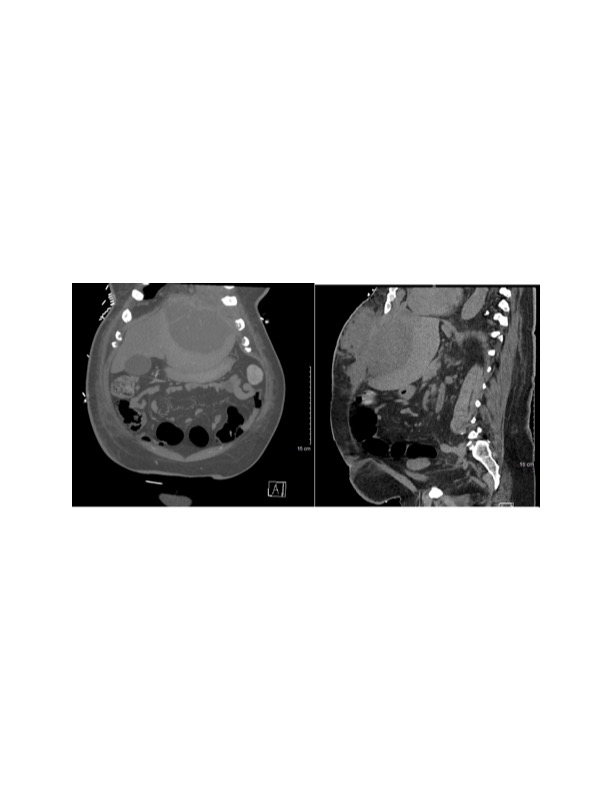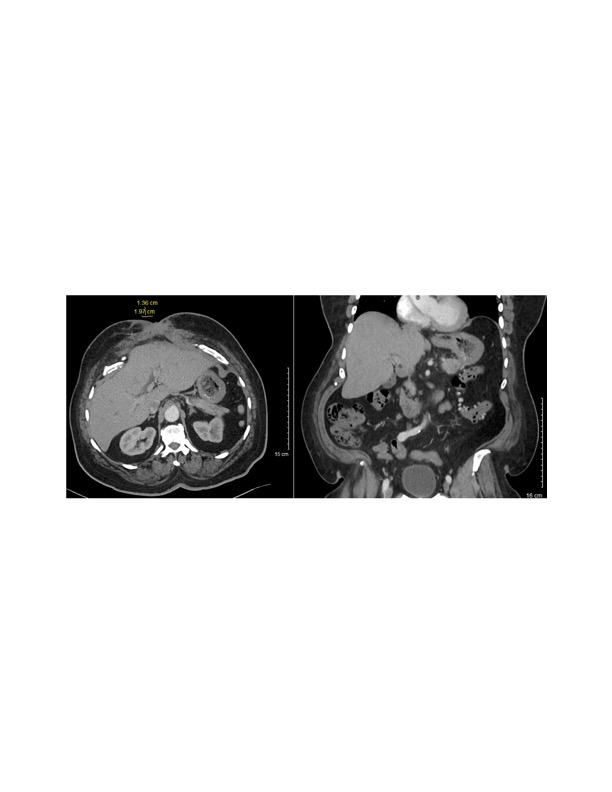Tuesday Poster Session
Category: Infections and Microbiome
P5634 - Lawsonella clevelandensis as a Rare Cause of Complex Liver and Abdominal Wall Abscess: A Case Report and Literature Review
Tuesday, October 28, 2025
10:30 AM - 4:00 PM PDT
Location: Exhibit Hall
- JK
Justin Kritzinger, MD (he/him/his)
McGill University
Montreal, QC, Canada
Presenting Author(s)
Justin Kritzinger, MD, Ling Yuan Kong, MD
McGill University, Montreal, PQ, Canada
Introduction: Lawsonella clevelandensis is a Gram-positive, partially acid-fast, anaerobic bacillus first described in 2013, increasingly recognized in deep-seated infections such as abscesses. Due to its fastidious nature, it is often undetectable by routine culture and typically requires 16S sequencing for identification. Here, we describe a case of a complex, multiloculated liver and abdominal wall abscess caused by L. clevelandensis, highlighting the diagnostic and therapeutic challenges associated with this emerging pathogen.
Case Description/
Methods: A 73-year-old man presented with a one-month history of epigastric pain and signs of a soft tissue infection at a prior surgical site. Imaging revealed a large rim-enhancing abscess involving the left hepatic lobe, abdominal wall, and mediastinum. He required multiple drainage procedures for recurrent abscess formation, in addition to broad-spectrum antibiotics. All cultures remained negative prompting 16S molecular sequencing, which ultimately identified L. clevelandensis. The patient improved following insertion of three separate pig-tail drains and treatment with broad spectrum intravenous antibiotics that were eventually transitioned to oral amoxicillin-clavulanic acid. He completed a total of three months of antibiotic therapy with no recurrence at ten-month follow-up.
Discussion: To date, only five cases of intra-abdominal or hepatic abscesses due to L. clevelandensis have been reported. Common features include older age, immunocompromise (especially diabetes), and history of prior abdominal surgery, suggesting the skin or gastrointestinal tract as a possible source. Our case is notable for its extensive spread across tissue planes, recurrence, and delayed resolution—hallmarks also observed in actinomycosis infection, a condition with overlapping clinical and morphologic features. No standardized treatment regimen exists, however reported cases often respond to amoxicillin-clavulanic acid following identification via 16S sequencing.
This case underscores the importance of considering L. clevelandensis in the differential diagnosis of culture-negative liver or intra-abdominal abscesses, particularly in immunocompromised patients. Clinicians should pursue molecular diagnostics when conventional cultures fail and involve infectious diseases specialists early. Recognition of this elusive pathogen can facilitate timely diagnosis and appropriate therapy, reducing morbidity associated with delayed or inadequate treatment.

Figure: Contrast abdominal CT showing liver abscess at initial
presentation.

Figure: Contrast abdominal CT showing abscess improvement five
months after initial presentation
Disclosures:
Justin Kritzinger indicated no relevant financial relationships.
Ling Yuan Kong indicated no relevant financial relationships.
Justin Kritzinger, MD, Ling Yuan Kong, MD. P5634 - <i>Lawsonella clevelandensis</i> as a Rare Cause of Complex Liver and Abdominal Wall Abscess: A Case Report and Literature Review, ACG 2025 Annual Scientific Meeting Abstracts. Phoenix, AZ: American College of Gastroenterology.
McGill University, Montreal, PQ, Canada
Introduction: Lawsonella clevelandensis is a Gram-positive, partially acid-fast, anaerobic bacillus first described in 2013, increasingly recognized in deep-seated infections such as abscesses. Due to its fastidious nature, it is often undetectable by routine culture and typically requires 16S sequencing for identification. Here, we describe a case of a complex, multiloculated liver and abdominal wall abscess caused by L. clevelandensis, highlighting the diagnostic and therapeutic challenges associated with this emerging pathogen.
Case Description/
Methods: A 73-year-old man presented with a one-month history of epigastric pain and signs of a soft tissue infection at a prior surgical site. Imaging revealed a large rim-enhancing abscess involving the left hepatic lobe, abdominal wall, and mediastinum. He required multiple drainage procedures for recurrent abscess formation, in addition to broad-spectrum antibiotics. All cultures remained negative prompting 16S molecular sequencing, which ultimately identified L. clevelandensis. The patient improved following insertion of three separate pig-tail drains and treatment with broad spectrum intravenous antibiotics that were eventually transitioned to oral amoxicillin-clavulanic acid. He completed a total of three months of antibiotic therapy with no recurrence at ten-month follow-up.
Discussion: To date, only five cases of intra-abdominal or hepatic abscesses due to L. clevelandensis have been reported. Common features include older age, immunocompromise (especially diabetes), and history of prior abdominal surgery, suggesting the skin or gastrointestinal tract as a possible source. Our case is notable for its extensive spread across tissue planes, recurrence, and delayed resolution—hallmarks also observed in actinomycosis infection, a condition with overlapping clinical and morphologic features. No standardized treatment regimen exists, however reported cases often respond to amoxicillin-clavulanic acid following identification via 16S sequencing.
This case underscores the importance of considering L. clevelandensis in the differential diagnosis of culture-negative liver or intra-abdominal abscesses, particularly in immunocompromised patients. Clinicians should pursue molecular diagnostics when conventional cultures fail and involve infectious diseases specialists early. Recognition of this elusive pathogen can facilitate timely diagnosis and appropriate therapy, reducing morbidity associated with delayed or inadequate treatment.

Figure: Contrast abdominal CT showing liver abscess at initial
presentation.

Figure: Contrast abdominal CT showing abscess improvement five
months after initial presentation
Disclosures:
Justin Kritzinger indicated no relevant financial relationships.
Ling Yuan Kong indicated no relevant financial relationships.
Justin Kritzinger, MD, Ling Yuan Kong, MD. P5634 - <i>Lawsonella clevelandensis</i> as a Rare Cause of Complex Liver and Abdominal Wall Abscess: A Case Report and Literature Review, ACG 2025 Annual Scientific Meeting Abstracts. Phoenix, AZ: American College of Gastroenterology.
